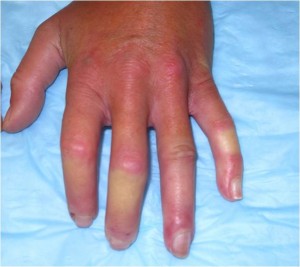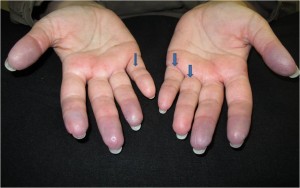Have you noticed that you have cold hands even in mild weather when others around you do not? Do you experience pain in your fingers at cold temperatures? Do you have to wear gloves when handling frozen foods in the grocery store? Have you noticed your hands changing color like white, blue or red? Do you have problems healing minor wounds on your fingertips?
If you answered ‘yes’ to any of these questions you might have a cold hand disease that can be treatable. Most cold hand diseases occur because of blood flow to your hands. In any of these cases the most important step you can take toward better hand health is to be examined by a hand specialist.
What causes a cold hand

To understand what causes hand to be cold first you must understand how the body keeps hands warm in the normal situation. Our bodies keep our hands warm primarily by regulating the blood flow that travels from the heart, down the arm, all the way to our fingertips—more blood to the hands means pink, warmer hands; less blood flow means colder (and sometimes painful) hands.
Blood that flows into our hands usually travels by only two arteries: the radial artery and the ulnar artery. These arteries course through the forearm into the hand on either side of the wrist. When looking at your palm, the radial artery travels on the thumb side and the ulnar artery on the small finger side. Both arteries join together in the palm and send off branches to each finger.
Normal Hand Anatomy
In the cold hand, disease of the blood vessels in the hand can cause decrease blood to the hands in two major ways: vasoconstriction and vaso-occlusion. Vasoconstriction refers to the blood vessels of the hand and wrist becoming smaller in diameter. There are normal muscles around all the major arteries of our body which are regulated automatically to constrict and decrease blood flow or to relax and increase blood flow.
 Think of a garden how watering a lawn. If you step on the hose with increasing pressure the flow of the water out of the faucet decreases. As you take your foot off the hose the water flow increases. That is essentially what the body does to change the amount of blood flow to your hands. This is a normal process that normal hand angiography.jpgallows the body to send more blood and warmth to the critical organs of your body (like you heart, lungs, and brain) and temporarily decrease to blood flow to your hands and feet.
Think of a garden how watering a lawn. If you step on the hose with increasing pressure the flow of the water out of the faucet decreases. As you take your foot off the hose the water flow increases. That is essentially what the body does to change the amount of blood flow to your hands. This is a normal process that normal hand angiography.jpgallows the body to send more blood and warmth to the critical organs of your body (like you heart, lungs, and brain) and temporarily decrease to blood flow to your hands and feet.
Cold hand diseases that occur from vasoconstriction happen when the normal process of temporarily applying more muscle pressure to your blood vessels becomes abnormally strong or prolonged. You can imagine if someone always had a foot on the with which hose you were trying to water your lawn that grass would eventually turn colors from green to brown and wither; the same happens with hands.
With less blood flow to the hands the oxygen content of the fingers is depleted, they can turn a blue color—a process called cyanosis.
 When the fingers are warmed up again, the increased blood flow causes a red color; this process is frequently accompanied with a new onset of pain. After a while, the fingers return to normal skin color, which can be associated with swelling and tingling.
When the fingers are warmed up again, the increased blood flow causes a red color; this process is frequently accompanied with a new onset of pain. After a while, the fingers return to normal skin color, which can be associated with swelling and tingling.
If the process becomes worse, the repeated and increasingly prolonged depletion of blood flow to the fingers can cause ulcers in the skin and tissue death (also called necrosis).
There are many specific diseases of blood vessels that can cause these changes. One of the most common vascular diseases is Raynaud’s. In this disease process, there is an abnormal reaction in the hand when it is exposed to cold.

With Raynaud’s, there are actually two vascular disease processes with the same name. When a patient has hypersensitive reaction to cold and no other vascular disease, this process is called Raynaud’s disease (or primary Raynaud’s); there is no other cause for the changes in the hand blood flow except for this abnormal reaction to cold exposure. Raynaud’s disease often develops in women in their teens and early adulthood. Primary Raynaud’s is thought to be at least partly hereditary, although the specific genes have yet to be identified.
When a patient experiences abnormal reactions to cold and has another vascular disease (such as lupus, scleroderma or rheumatoid arthritis), this process is called Raynaud’s phenomenom (or secondary Raynaud’s). Diseases associated with Raynaud’s phenomenon include:
- systemic lupus erythematosus
- scleroderma
- systemic sclerosis
- rheumatoid arthritis
- CREST syndrome
- Sjogren’s syndrome
- Buerger’s disease (Thromboangitis Obliterans)
- obstructive arterial disease
The other cause of cold hand or fingers is vaso-occlusion which happens when one or more of the blood vessels in the hand or wrist become blocked.
How are Cold Hand Diseases Treated?
Diagnosis
One critical aspect to treating cold hand disorder is to determine the cause of why your hands become abnormally cold. Most people have the simple cold hand condition type where the cause is located in the blood vessels of the hands (and/or feet) but nowhere else. However, a smaller group of people have a related systemic disease (as mentioned above) that can significantly affect other parts of the body. Your hand specialist can help you get evaluated by other specialists (like rheumatologist, hematologist/oncologists) to determine if you might have one of these cold hand-related systemic diseases. If you do have one of these illnesses then, treatment exists to help you and decrease it chances of affecting other organ systems.
Behavioral Counseling
A hand surgeon may help you identify behaviors that may be helpful or harmful to blood flow in your the hands. Our doctors educate patients on a range of behavioral topics, including:
- Proper hand hygiene (e.g., correct moisturizing options, appropriate skin care)
- Wearing warm and protective hand wear (e.g., guidance in glove type choices and usage)
- Healthy temperature regulation
- Biofeedback
- Smoking cessation
Drug Therapy
In many cases, our doctors may prescribe medicines that reduce the risk of developing blocked or constricted blood vessels, and improve blood flow through the hands and fingers.
Effective medications include:
- Calcium channel blockers: oral and topical medications used to relax the muscles that place pressure on blood vessels
- Antidepressants: used with calcium channel blockers to regulate pressure in the blood vessels and help maintain a proper amount of blood flow throughout the entire hand
- Anticoagulants (blood thinners): oral medications used to reduce the risk of blood clotting and other blockages of blood flow through upper limb vessels
- Phosphodiesterase (PDE) inhibitors: oral medications like Viagra and Cialis that are used to increase blood flow for erectile dysfunction have also been preliminarily shown to aid in increase blood flow to the hands to treat cold symptoms.
Botox Injections
Most commonly recognized as a cosmetic procedure, botulinum toxin (Botox) injections are now used as a highly effective treatment for cold hands syndrome. In a simple outpatient procedure, Botox is injected into the hand to relax muscles surrounding constricted blood vessels. Botox paralyzes and relaxes the muscles, allowing blood vessels to dilate and increase in diameter. As the vessels dilate, more blood can flow through to supply the rest of the hand and the fingertips. This procedure may provide relief of cold hand symptoms in certain individuals for up to three months.
Surgical Treatment
Surgery is often the best treatment option for complex cold hand diseases. A hand surgeon may perform a range of advanced techniques.
Surgical treatment options include:
- Sympathectomy: a microsurgical technique used to separate the nerves and vessels in the forearm, palm (palmar sympathectomy) or fingers (digital sympathectomy). When nerves are separated, the vessels become larger, allowing increased blood flow through the hands and fingertips.
- Aneurysm repair: repair of an aneurysm by inserting a stent to strengthen a weak blood vessel, or aneurysm removal followed by replacement with a graft of healthy vascular tissue
- Thrombectomy: blood clot removal using microsurgery techniques
- Vascular bypass: blood flow around an obstructed segment of the blood vessel




